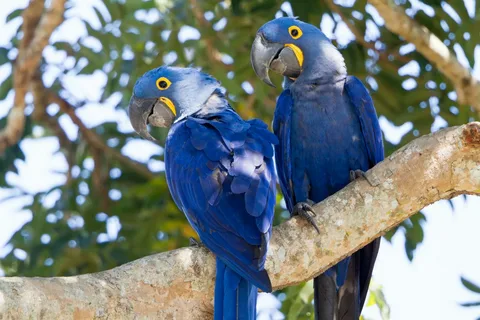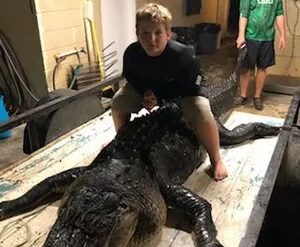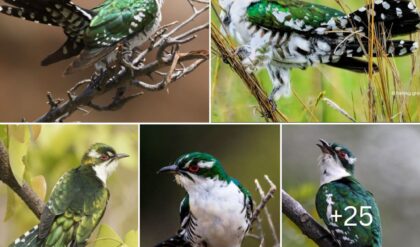The largest parrot by length in the world, the hyacinth macaw is 1 m (3 ft 3 in) long from the tip of its tail to the top of its head and weighs 1.2–1.7 kg (2 lb 10 oz – 3 lb 12 oz). Each wing is 38.8–42.5 cm (15+1⁄4–16+3⁄4 in) long.The tail is long and pointed. Its feathers are entirely blue, lighter above. However, the neck feathers can sometimes be slightly grey. The ring around the parrot’s eyes and the area just underneath the beak are a strong, vibrant yellow.

The majority of the hyacinth macaw diet is composed of nuts from specific palm species, such as acuri and bocaiuva palms. They have very strong beaks for eating the kernels of hard nuts and seeds. Their strong beaks are even able to crack coconuts, the large Brazil nut pods, and macadamia nuts. The birds also boast dry, smooth tongues with a bone inside them that makes them an effective tool for tapping into fruits. The acuri nut is so hard that the parrots cannot feed on it until it has passed through the digestive system of cattle. In addition, they eat fruits and other vegetable matter. The hyacinth macaw generally eats fruits, nuts, nectar, and various kinds of seeds. Also, they travel for the ripest of foods over a vast area.

Nesting takes place between July and December, with nests constructed in tree cavities or cliff faces depending on the habitat. In the Pantanal region, 90% of nests are constructed in the manduvi tree (Sterculia apetala). The hyacinth macaw depends on the toucan for its livelihood. The toucan contributes largely to seed dispersal of the manduvi tree that the macaw needs for reproduction. However, the toucan is responsible for dispersing 83% of the seeds of Sterculia apetala, but also consumes 53% of eggs preyed. Hollows of sufficient size are only found in trees around 60 years of age or older, and competition is fierce. Existing holes are enlarged and then partially filled with wood chips. The clutch size is one or two eggs, although usually only one fledgling survives as the second egg hatches several days after the first, and the smaller fledgling cannot compete with the firstborn for food. A possible explanation for this behaviour is what is called the insurance hypothesis. The macaw lays more eggs than can be normally fledged to compensate for earlier eggs that failed to hatch or firstborn chicks that did not survive. The incubation period lasts about a month, and the male tends to his mate whilst she incubates the eggs. The chicks leave the nest, or fledge, around 110 days of age, and remain dependent on their parents until six months of age. They are mature and begin breeding at seven years of age.



